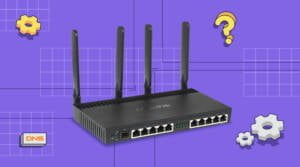Definition of WAN and its functions
A WAN (Wide Area Network) is a computer network that covers a large area, often distributed around the world. It connects computers and other devices using the Internet and other communication technologies, such as cellular and satellite communications. The main function of a WAN is to provide communication between different local area networks (LANs) in different geographic areas. This allows companies and organizations to link their offices in different parts of the world, exchange data, and provide remote access to resources and applications. One of the features of a WAN is that it can use a variety of communication protocols and technologies. For example, a WAN can use network protocols such as TCP/IP and Ethernet, as well as specialized protocols such as Frame Relay and ATM. In addition, a WAN can use a variety of communication technologies, such as line, cellular, satellite, and optical cables. This allows the most effective communication technology to be used for each specific situation. Overall, a WAN plays an important role in communicating between different LANs and ensures the efficient functioning of many companies and organizations around the world.
How to distinguish WAN from LAN
In order to understand what a WAN is, it is necessary to distinguish it from a LAN. LAN (Local Area Network) is a local network limited to the territory of one building or a small area. Such a network is used to exchange data between computers installed in the same building or office.
WAN (Wide Area Network) is a global network that connects computers and other devices in different cities, countries and continents. The Internet is an example of a WAN.
The main difference between WAN and LAN is their size. A LAN is a small network that is limited to the territory of one building or office. WAN is a global network that connects computers and devices over long distances.
In addition, WAN uses more complex technologies and has a higher cost than LAN. For example, connecting to a WAN may require special equipment and connection setup.
Thus, you can distinguish a WAN from a LAN by their size and the technologies used. If you want to connect to the global network, then you need access to the WAN. If you want to create a local network in your office or home, then you need a LAN.
Benefits of using WAN
A WAN is a network that allows you to connect computers and devices in different geographic locations. It can be used in both corporate and government networks. Here are a few benefits of using a WAN:
- Remote access – thanks to the WAN, employees can work from anywhere in the world with access to the necessary data and applications.
- Collaboration – WAN allows employees to work on the same files even if they are in different cities or countries. This improves work efficiency.
- Data Exchange – WAN enables fast and secure data exchange between different offices, even if they are located in different parts of the world.
- Reduced Costs – By using a WAN, companies can reduce travel costs, office rentals, and other costs associated with offices in different cities and countries.
Types of Technologies Used in WAN
WAN (Wide Area Network) is a type of computer network that allows you to connect computers and devices located over large distances. Various technologies are used for this, including:
1. Optical fiber communication lines (OFCL) is a technology for transmitting data using light signals through glass fibers. OFCL provides high data rates over long distances and has low latency.
2. Satellite communication is a technology for transmitting data via a satellite communication system. It is used in situations where other communication technologies are not available, such as in remote areas or on ocean liners.
3. Digital Subscriber Lines (DSL) is a technology for transmitting data over telephone lines. It is used in cases where there is no access to OVLS or other communication technologies.
4. T1 communication lines are a technology for transmitting data via special T1 communication lines that provide high data transfer rates over distances of up to 50 km.
Depending on your specific situation, you can use any or a combination of these technologies to connect computers and devices over long distances.
Frame relay is one of the most common protocols for data transmission in WAN computer networks. It operates at the communication link level and provides high data transfer speeds, reliability and efficient use of network bandwidth. One of the features of frame relay is the use of virtual channels, which allows you to divide a physical channel into several logical ones, each of which can have its own data transfer parameters. In addition, frame relay monitors data transmission errors and automatically retransmits them if they occur.
ATM (Asynchronous Transfer Mode) is a data transfer technology used in WAN networks. It was developed to provide high speed and reliability of data transfer.
ATM uses cell switching, which means that each data packet is broken up into small cells of a fixed size and transmitted over the network. This allows you to increase data transfer speeds and reduce latency.
ATM also provides high reliability of data transmission through the use of error recovery and flow control mechanisms. This allows data to be transmitted in real time, which is especially important for the transmission of voice and video information.
In WAN networks, ATM is widely used to transfer data between remote offices of companies, banks and other organizations. It is also used for data transmission on mobile networks and the Internet.
Today, ATM is gradually giving way to new technologies such as Ethernet and MPLS, but it is still used in many WAN networks.
How to keep your WAN secure
WAN (Wide Area Network) is a network that allows you to connect computers and devices located at a great distance from each other. Using a WAN may pose security risks, so it is important to take steps to protect your data.
The first step to ensuring security when using a WAN is to use strong passwords and data encryption. You should also install a firewall and update it regularly.
Additional security measures may include the use of virtual private networks (VPNs), which allow you to create a secure connection over untrusted networks. You can also use the software to detect threats and attacks on your network.
Finally, it is important to train employees who operate the network on security rules so they can help ensure data security.
Overall, ensuring security when using a WAN is an important concern for any company using this technology. With the right security measures, you can protect your data and avoid information leaks.
VPN and its role in security
VPN (Virtual Private Network) is a technology that allows you to establish a secure connection between computers or networks over an unsecured network such as the Internet.
VPN is used to provide secure access to remote resources such as servers or databases, and to enable secure data transfer between offices located in different geographical locations.
One of the main advantages of a VPN is data encryption, which ensures privacy and protection from unauthorized access. In addition to this, a VPN allows you to bypass restrictions imposed by Internet service providers and gain access to blocked sites and services.
There are several types of VPNs, such as PPTP, L2TP and OpenVPN, each of which has its own advantages and disadvantages. However, regardless of the type you choose, a VPN is an important tool for maintaining security and privacy online.
Firewall and its application in WAN
A firewall is software or hardware that is used to protect computer networks from unauthorized access and other threats from the Internet. On a WAN, where a company's network connects to the Internet, protection against external threats becomes especially important.
A firewall can perform a number of functions, including blocking access to specific sites, restricting the use of certain applications, and controlling network access. It can also be used to monitor network traffic to detect and prevent attacks.
In a WAN, a Firewall can be located at the edge of a company's network, between local networks and the Internet, to protect internal resources from external threats. It can also be placed internally, between different parts of the network, to provide an additional layer of protection.
A firewall can be configured to block or allow access to specific ports, protocols, and applications. It can also be configured to filter traffic based on IP addresses or other parameters.
In general, Firewall is an important part of network security in a WAN. It helps prevent unauthorized access to a company's network and ensures the security of internal resources.
Read further:






